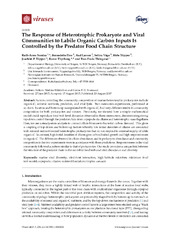| dc.contributor.author | Sandaa, Ruth-Anne | |
| dc.contributor.author | Pree, Bernadette | |
| dc.contributor.author | Larsen, Aud | |
| dc.contributor.author | Våge, Selina | |
| dc.contributor.author | Tøpper, Birte | |
| dc.contributor.author | Töpper, Joachim Paul | |
| dc.contributor.author | Thyrhaug, Runar | |
| dc.contributor.author | Thingstad, Tron Frede | |
| dc.date.accessioned | 2017-09-20T11:27:35Z | |
| dc.date.available | 2017-09-20T11:27:35Z | |
| dc.date.issued | 2017-08-23 | |
| dc.Published | Sandaa R, Pree B, Larsen A, Våge S, Tøpper B, Töpper J, Thyrhaug R, Thingstad TF. The Response of Heterotrophic Prokaryote and Viral Communities to Labile Organic Carbon Inputs Is Controlled by the Predator Food Chain Structure. Viruses. 2017;9:238 | eng |
| dc.identifier.issn | 1999-4915 | en_US |
| dc.identifier.uri | https://hdl.handle.net/1956/16680 | |
| dc.description.abstract | Factors controlling the community composition of marine heterotrophic prokaryotes include organic-C, mineral nutrients, predation, and viral lysis. Two mesocosm experiments, performed at an Arctic location and bottom-up manipulated with organic-C, had very different results in community composition for both prokaryotes and viruses. Previously, we showed how a simple mathematical model could reproduce food web level dynamics observed in these mesocosms, demonstrating strong top-down control through the predator chain from copepods via ciliates and heterotrophic nanoflagellates. Here, we use a steady-state analysis to connect ciliate biomass to bacterial carbon demand. This gives a coupling of top-down and bottom-up factors whereby low initial densities of ciliates are associated with mineral nutrient-limited heterotrophic prokaryotes that do not respond to external supply of labile organic-C. In contrast, high initial densities of ciliates give carbon-limited growth and high responsiveness to organic-C. The differences observed in ciliate abundance, and in prokaryote abundance and community composition in the two experiments were in accordance with these predictions. Responsiveness in the viral community followed a pattern similar to that of prokaryotes. Our study provides a unique link between the structure of the predator chain in the microbial food web and viral abundance and diversity. | en_US |
| dc.language.iso | eng | eng |
| dc.publisher | MDPI | en_US |
| dc.rights | Attribution CC BY | eng |
| dc.rights.uri | http://creativecommons.org/licenses/by/4.0 | eng |
| dc.subject | marine viral diversity | eng |
| dc.subject | viral–host interaction | eng |
| dc.subject | high latitude microbes | eng |
| dc.subject | minimum food web model | eng |
| dc.subject | copepods | eng |
| dc.subject | ciliates | eng |
| dc.subject | nutrient limitation | eng |
| dc.subject | trophic cascade | eng |
| dc.title | The Response of Heterotrophic Prokaryote and Viral Communities to Labile Organic Carbon Inputs Is Controlled by the Predator Food Chain Structure | en_US |
| dc.type | Peer reviewed | |
| dc.type | Journal article | |
| dc.date.updated | 2017-09-07T10:09:24Z | |
| dc.description.version | publishedVersion | en_US |
| dc.rights.holder | Copyright 2017 The Author(s) | en_US |
| dc.identifier.doi | https://doi.org/10.3390/v9090238 | |
| dc.identifier.cristin | 1489464 | |
| dc.source.journal | Viruses | |
| dc.relation.project | Norges forskningsråd: 175939 | |
| dc.relation.project | Andre: European Research Council Advanced Grant ERC-AG-LS8 | |
| dc.relation.project | Norges forskningsråd: 225956 | |
| dc.subject.nsi | VDP::Matematikk og naturvitenskap: 400::Zoologiske og botaniske fag: 480 | |
| dc.subject.nsi | VDP::Mathematics and natural scienses: 400::Zoology and botany: 480 | |

